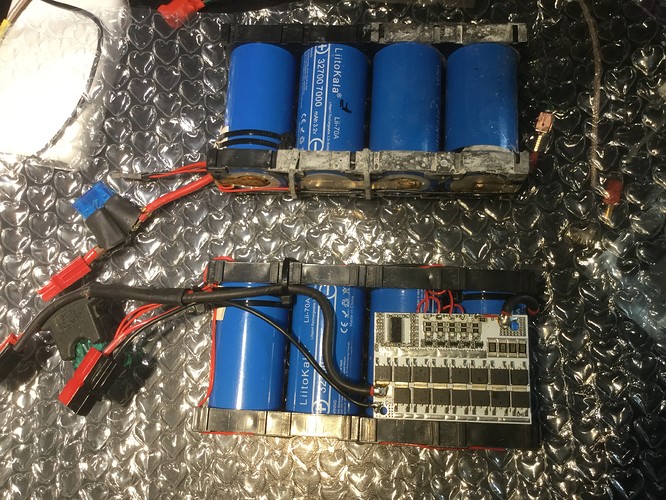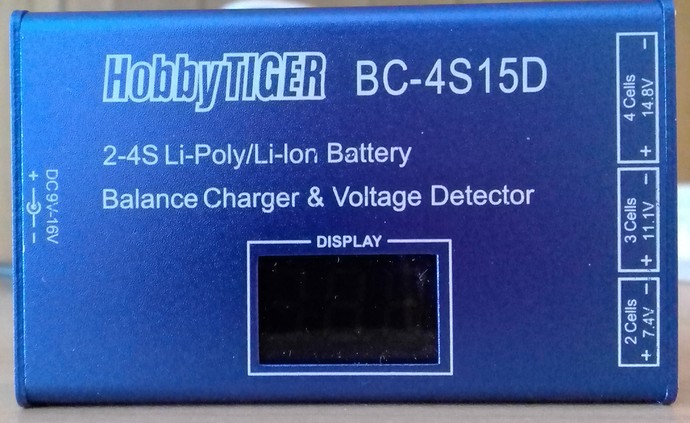Backgorund
For years I have been using LiPo batteries to power my rigs in the field.
They are cheap, it is easy to find R/C LiPo cells on stock, a 3S pack works fine and I have used several of them without troubles. They last for years if you are careful with its charging and discharging process, but still have some issues:
- You better keep them on a fireproof safe bag just in case of self ignition (rare).
- Supervision advised during charging.
- The cells tend to swell with time (years), indicating ageing and progressive degradation.
Searching for alternatives, some people have migrated towards LiFePO4 chemistry, a safer option, although sometimes it is hard to find them on stock. They are also a bit pricey.
Another technology at hand is Li-Ion. This technology was introduced many years ago in consumers, like cameras and electrical appliance, and they are developed widely.
An easy source are 18650 cells, that some people get from salvaged laptop packs, or buy them spare. They are a bit bigger than a standard AA size battery, and have more capacity.
It is easy to build a 3 cell pack with such 18650 cells and power a small rig, like the MTR. Myself, I have one of such packs:
The only concern I found is they are a bit limited when powering bigger rigs, with higher RX & TX currents, and therefore, I can’t run a long activation with them, although it’s still possible if you do a short one. Is it because I bought a cheap brand with low capacity, maybe?
Thinking that I would need a bit more of capacity I found the 21700 cell, a big brother of the 18650. Let’s see if this one can also be used to power my portable rigs for SOTA activation.
Features
Both the 18650 and the 21700 can be found as the hearth of several power packs in the market.
Why this extrange name, you could think? It is not that complex, they indicate its diameter and length:
- 18650 is 18 mm diameter and 65 mm length. Weight: 39 gram (1,37 oz).
- 21700 is 21 mm diameter and 70 mm length. Weight: 70 gram (2,47 oz).
If you compare both Li-Ion cells, the 21700 has 23% bigger volume compared to 18650.
Maximum capacity rated for a 18650 is about 3500 mAmp. You could say this is well enough to power any of our small radios in the wild, but the truth is you can never get all that current from them. Why? Because during the supply, the voltage will drop to a value that is degrading the performance of the rig, and therefore you have to stop using them even when there is a residual amount of current that you can’t get.
What about 21700 then?
Due to its increased volumen, they are 33% more capacity, thus they could supply 4800 mAmp (a good brand), but remember you could never get all that current as you should stop early to avoid a deep discharge that could damage the battery.
Preparing the pack
With all that data at hand I was motivated to give them an opportunity.
How could I prepare a pack? First calculate how many cells to join in series.
-
Nominal cell voltage: 3,6 volts
-
Fully charged voltage: 4,2 volts (hey, that’s exactly the same as for a LiPo!)
I decided to prepare a 3S pack, as they would supply 12,6 volts when fully charged. Having a 4S pack would provide 16,8 V which is too much. Yes, you can still add diodes in series to reduce voltage but that is wasting your power. 12,6 V is okay with current small rigs.
How could I connect them in series? There are techniques to solder them, but for convenience, I find more useful putting them in a battery holder.
To be honest, it is easier to find such holders for 18650 than for 21700, but it wasn’t that hard to find an offer for a 3D printer holder for 21700. They come with Keystone contacts, and you just need to solder some wires to put the cell in series.
I bought 3 of them and prepared a pack, adding a power switch to ensure they are off when I walk with them on my backpack, and put a XT60 connector in the outlet:
Then I bought three 21700 Samsung 40T cells. They are rated 4000 mAmp. Some people say there are fake cells that look very similar to the real ones. I don’t know which one I bought. Price is about 9 euros each; reasonable.
They came loaded to 40% that is the custom if you intend to store them for a long time, as the shops do.
I also bought a specific charger for them, that I could easily transport with me and not beinig bulky. It indicates the charged current during process and monitors each cell individually:
When I first charged them they stopped fully loaded with about 2600 mAmp. Remember they were partly loaded as a storage charge.
The pack was ready for the field.
Field test
The pack was fully charged, so I went and activate the summit EA2/NV-119 monitoring the data. To make things harder, it had snowed receintly, so I would face a real hard test on them. They do not recommend to use lithium batteries at low temperatures, but that would be a good test to know how they work in hard condition.
Let’s see some data I annotated during my trial:
-
Temperature: -2 C
-
Start of the activation voltage: 12,3 V (they show 12,6 V on the multimeter, but 12,3 when the rig is just powered on).
-
Activation duration: the radio was on for 1 hour 40 minutes, 65 minutes from which were used running the pile up or working S2S . I never stopped the radio when QSY.
-
RX current: 0,17 Amp.
-
TX current: 1,8 Amps (radio set to 7w out).
-
QSO: 73 contacts on 7, 10 and 14 MHz CW and SSB.
-
End of activation voltage: 11,3 V (1 volt drop).
Cheching the current consumption when back at home
In order to know what was the current used during the activation, I put them in the charger to fully load them again.
-
Pack voltage after one day storage: 11,7 volts. They were too cold when back at home so I better put them to charge after allowing to warm and stabilize.
-
Time to fully charge them after the activation: 2h 15 minutes
-
Current charged: 804 / 906 / 876 per cell (862 mAmps average).
This means I used less than 1 amp in 1h and a half activation time.
By looking at the results, I could use these cells for a longer time on an activation.This is a good result taking into account I used them on a very cold day.
Test is passed satisfactorily; this is going to be my main pack for SOTA activation from now on.
Any beta tester interested on building a pack and checking it? With 210 gram it is a light pack that does worth to bear in mind.
73 de Ignacio












